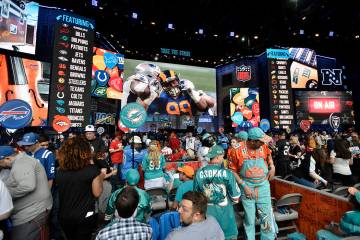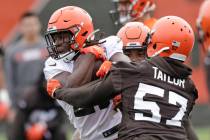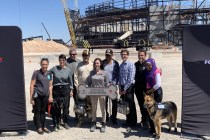Experts: Challenge to build Las Vegas Raiders stadium for 2020
Southern Nevada construction industry experts say whoever ends up building the planned 65,000-seat stadium for the Las Vegas Raiders will face a massive challenge to get it done by the opening of the 2020 NFL season.
The enormity of the project, the long checklist of approvals necessary to get started and a potential labor shortage once work begins are among the roadblocks facing the Raiders, their development partner and the Las Vegas Stadium Authority.
Between today and the middle of August 2020 are 1,231 days. It took contractors working on Jerry Jones’ spectacular 80,000-seat AT&T Stadium for the Dallas Cowboys 1,346 days to complete from groundbreaking to ribbon-cutting. And three experts who have experience on projects in Southern Nevada say the Raiders will be lucky to get started within 18 months.
“With everything that has to be done, it all has to fall into place just right for it to work,” said J. Tito Tiberti, former president of J.A. Tiberti Construction, whose company has built several major projects in Southern Nevada, including 16 hotel-casinos, 20 schools and 60 water and wastewater projects.
Tiberti also is one of nine members of the Las Vegas Stadium Authority board.
“I think it’s a good 18 months of planning and permitting and I think the construction has got to take two years,” Tiberti said.
Tiberti, development consultant Gary Lake and project manager Paul Monar, who worked on a number of Marnell Corrao projects with developer Tony Marnell, talked with the Review-Journal about the challenges that await the stadium project.
Green light
The good news for the Raiders is that now that the NFL has green-lighted the team’s relocation from Oakland to Las Vegas, work can begin in earnest on multiple fronts and some of the paperwork necessary to begin moving dirt can be done simultaneously.
The Raiders won’t confirm they’ve retained architect David Manica whose Kansas City, Missouri, firm has provided a series of renderings of what the stadium could look like. Manica has an impressive resume of international stadium projects under his belt and the Raiders have posted on their website that the Las Vegas stadium would have a rigid glass-domed roof and retractable doors that would open to the north for a killer view of the Las Vegas Strip. That assumes that the Raiders purchase the 62 acres they have an option on just north of Russell Road adjacent to Interstate 15.
Now that relocation has been approved, several other stadium site pitches are expected to be made, but team executives seem firm on the Russell location.
International experience
Manica has produced designs for Reliant Stadium in Houston, a renovation for Dolphins Stadium in Miami, a concept design for Inter Milan Stadium in Italy, the Nou Camp Nou stadium renovation in Barcelona and a renovation concept for San Paolo Stadium in Naples, Italy. The firm also has been behind proposals for a Los Angeles stadium in Carson, California, an Oakland A’s baseball stadium and a combined stadium and convention center plan for the San Diego Chargers that was rejected by voters.
The Raiders still have to sign a stadium development agreement with the Las Vegas Stadium Authority, a topic that may come up at the board’s next meeting, April 20. Authority staff have said they don’t expect development and lease agreements will be ready for consideration by the nine-member board by the April or even May meetings.
The board has to be convinced that the Raiders and their development team are qualified to do the work they promise.
Big hurdles
The paperwork is only the first hurdle to clear. There are more:
■ Power. The stadium will need plenty of electricity. Where will it come from? Contractors will need to negotiate with NV Energy about utility lines, energy corridors and, possibly, substations. Tiberti said with the number of projects underway, there could be a long line at NV Energy to solve potential power problems.
■ Broadband. The ability to move data is extremely important to the NFL and it’s expected that developing the broadband to meet those needs will be a top priority. “It’s staggering to consider how much the stadium will need,” Tiberti said.
■ Drainage. Developers will be required to file plans that show the flow of water when the region gets hammered by one of those summer monsoon flash floods. Drainage studies are critical for flood control and are necessary to guarantee loans.
■ Water and sewer. Tiberti, Lake and Monar say that shouldn’t be a massive challenge, but upgrading water and sewer lines in the neighborhood surrounding the stadium may be a necessity since crews that put in existing pipes didn’t anticipate a massive stadium on that site. The fact that the primary site abuts I-15 may provide a challenge to develop sewer lines.
■ Soil studies. Developers will be required to drill 80 feet down to determine the stability of materials beneath the surface. There could be underground water; there could be unstable sand. Tiberti recalled that when Mandalay Bay — just across I-15 from the leading stadium site — was built, contractors had to shore up the building’s elevator shafts that sank an inch and threatened the building’s stability before it was shored up.
■ Traffic planning. An issue that has been raised by the Nevada Department of Transportation and the Regional Transportation Commission of Southern Nevada is to head off stadium-related traffic problems before they start. The Department of Transportation is considering moving up some already planned projects because they’d head off potential traffic woes. Among them: the redesign of the I-15-Tropicana Avenue interchange just north of the leading stadium site. Clark County Commissioner Larry Brown, who also chairs the Regional Transportation Commission, said he expects NDOT, the RTC, the Raiders and the county to discuss those issues in public forums before decisions are made.
■ Safety concerns. The Las Vegas Metropolitan Police Department and the Clark County Fire Department may need to review stadium ingress and egress to determine whether the proximity of fire stations and medical facilities are sufficient.
Near the airport
■ Once that preliminary planning is complete, construction could begin — but not before a few more details are ironed out. Because of the height of the tall cranes that will be needed for construction, developers will likely need clearance from the Federal Aviation Administration to proceed. That happened recently at Los Angeles Stadium at Hollywood Park in Inglewood, California, where the Los Angeles Rams and Chargers will play beginning in 2019. That site is close enough to Los Angeles International Airport for the FAA to review. The Las Vegas Stadium site should be close enough to McCarran International Airport for authorities to have a look.
■ The next big question for developers: Will there be enough labor available to move the project along? By the time the stadium project is ready to go, there will be other big projects underway: Project Neon. Resorts World Las Vegas. Projects at the Palms, Palace Station and Monte Carlo. The possible startup of the Las Vegas Convention Center expansion and renovation.
Workers gone
Tiberti also noted that after the Great Recession, many laborers left Southern Nevada or retired, depleting the workforce. Tiberti, Lake and Monar expect the general contractor for the project to be from out of state because they don’t believe there’s a company in Las Vegas that could handle such a project.
The stadium’s labor force will have another requirement. Within Senate Bill 1, the legislation that created the financing for the public’s $750 million contribution to the project, is a stipulation that 15 percent of the subcontracts for the project must be with small local businesses.
The contractor will have to vet small-business workforce and make sure that percentage is met.
Can the project be done on time for the 2020 season? Some of Southern Nevada’s big resort projects have been completed at remarkable paces.
Good weather
Southern Nevada has the advantage of having favorable weather to work year-round and in the hot summer months, it’s not uncommon for workers to labor in the late night and early-morning hours.
But good weather is no guarantee for a speedy project delivery. It took workers 1,208 days to complete University of Phoenix Stadium, home of the Arizona Cardinals, in 2006, yet it only took crews 963 days to finish U.S. Bank Stadium in Minneapolis in 2016.
The clock is ticking and the race is on.
Contact Richard N. Velotta at rvelotta@reviewjournal.com or 702-477-3893. Follow @RickVelotta on Twitter.






















